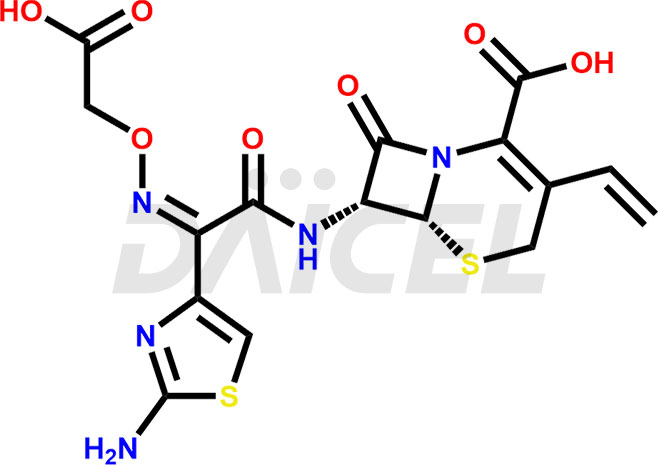Cefixime
General Information
Cefixime Impurities and Cefixime
Daicel Pharma synthesizes high-quality Cefixime impurities like Cefixime EP Impurity F and Cefixime Impurity-A, which are crucial in the analysis of the quality, stability, and biological safety of the active pharmaceutical ingredient Cefixime. Moreover, Daicel Pharma offers custom synthesis of Cefixime impurities and delivers them globally.
Cefixime [CAS: 79350-37-1] is an antibiotic derived semi-synthetically from a fungus called Cephalosporium acremonium. It is a third-generation cephalosporin antibiotic with a broad spectrum of activity against different types of bacteria.
Cefixime: Use and Commercial Availability
Cefixime is a broad-spectrum antibiotic that is effective against various infections caused by susceptible microorganisms. These infections include acute bronchitis and acute exacerbations of chronic bronchitis caused by Streptococcus pneumoniae and Haemophilus influenzae (beta-lactamase positive and negative strains). Further, it treats uncomplicated gonorrhea caused by Neisseria gonorrhoeae (penicillinase- and non-penicillinase-producing strains). Also, it aids in treating otitis media caused by Haemophilus influenzae (beta-lactamase positive and negative strains), Moraxella catarrhalis (mostly beta-lactamase positive), and S. pyogenes. Additionally, it treats uncomplicated urinary tract infections caused by Escherichia coli and Proteus mirabilis. The drug is available as an oral tablet under the brand name Suprax.
Cefixime Structure and Mechanism of Action
The chemical name of Cefixime is (6R,7R)-7-[[(2Z)-2-(2-Amino-4-thiazolyl)-2-[(carboxymethoxy)imino]acetyl]amino]-3-ethenyl-8-oxo-5-thia-1-azabicyclo[4.2.0]oct-2-ene-2-carboxylic acid. Its chemical formula is C16H15N5O7S2, and its molecular weight is approximately 453.5 g/mol.
Like other cephalosporins, Cefixime inhibits the cell wall synthesis of bacteria. It is highly stable in the presence of beta-lactamase enzymes.
Cefixime Impurities and Synthesis
Impurities are substances that are unintentionally present in pharmaceuticals and can affect the quality, efficacy, and safety. Cefixime1, a widely used antibiotic, is no exception and can contain impurities that arise from various sources. These impurities include related compounds such as intermediates, by-products of Cefixime synthesis, and degradation products that form during storage or under unfavorable conditions. Therefore, manufacturers must develop and validate analytical methods to accurately detect and quantify impurities in Cefixime. Manufacturers can minimize impurity formation and improve the quality of Cefixime by implementing process control and optimization strategies, such as using high-quality starting materials, optimizing reaction conditions, and using appropriate purification techniques. Ultimately, ensuring the purity of Cefixime is essential to ensure its safety and efficacy for patients.
Daicel offers a Certificate of Analysis (CoA) from a cGMP-compliant analytical facility for Cefixime impurity standards, Cefixime EP Impurity F, and Cefixime Impurity-A. The CoA includes complete characterization data, such as 1H NMR, 13C NMR, IR, MASS, and HPLC purity2. We also provide 13C-DEPT and CHN on request. We give a complete characterization report on delivery. Daicel has the technology and expertise to prepare any unknown Cefixime impurity or degradation product.
References
FAQ's
References
- Takaya, Takao; Takasugi, Hisashi; Masugi, Takashi; Yamanaka, Hideaki; Kawabata, Kohji, 7-Acylamino-3-vinylcephalosporanic acid derivatives and processes for the preparation thereof, Fujisawa Pharmaceutical Co., Ltd., Japan, US4409214A, October 11, 1983
- Tokuma, Yoji; Shiozaki, Yoko; Noguchi, Hideyo, Determination of a new orally active cephalosporin in human plasma and urine by high-performance liquid chromatography using automated column switching, Journal of Chromatography, Biomedical Applications, Volume: 311, Issue: 2, Pages: 339-46, 1984
Frequently Asked Questions
What are the effects of Cefixime impurities shelf life of the drug?
Cefixime impurities can shorten the drug's shelf life by accelerating degradation and reducing stability.
Which solvent helps in the analysis of Cefixime impurities?
Water is used as a solvent in the analysis of the Cefixime impurities.
What are the temperature conditions required to store Cefixime impurities?
Cefixime impurities should be stored at a controlled room temperature between 2-8 ⁰C or as indicated on the Certificate of Analysis (CoA).
Note: Products protected by valid patents by a manufacturer are not offered for sale in countries having patent protection. The sale of such products constitutes a patent infringement, and its liability is at the buyer's risk.



